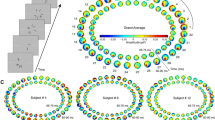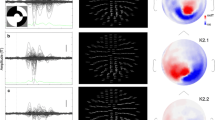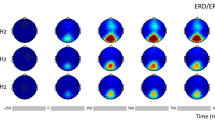Abstract
While the relationship between sensory stimulation and tasks and the size of the cortical activations is generally unknown, the visual modality offers a unique possibility of an experimental manipulation of stimulus size-related increases of the spatial extent of cortical activation even during the earliest activity in the retinotopically organized primary visual cortex. We used magnetoecephalography (MEG), visual stimuli of increasing size, and numerical simulations on realistic cortical surfaces to explore the effects of increasing spatial extent of the activated cortical sources on the neuromagnetic fields, location estimation biases, and source resolution. Source localization was performed assuming multiple dipoles in a sphere model using an efficient, automatically restarted multi-start simplex minimizer within the Calibrated Start Spatio-Temporal (CSST) algorithm. We found size-related effects on amplitude and latencies and differences in relative locations of the earliest occipital sources evoked by stimuli of increasing size presented at the same eccentricity. This finding was confirmed by single patch simulations. Additionally, simulations of multiple extended sources demonstrated size-related increase in limits in source resolution for bilaterally simulated sources, biases in location estimates for a given separation of sources, and limits in source resolution due to source multiplicity within a hemisphere.






Similar content being viewed by others
References
Aine CJ (2010) Highlights of 40 years of SQUID-based brain research and clinical applications. In: Supek S, Susac A (eds) IFMBE proceedings 17th international conference on biomagnetism advances in biomagnetism—Biomag 2010, vol 28. Springer, Heidelberg, pp 9–34
Aine CJ, Supek S, George JS, Ranken D, Lewine J, Sanders J, Best E, Tiee W, Wood CC (1996) Retinotopic organization of human visual cortex: departures from the classical model. Cereb Cortex 6:354–361
Aine C, Huang M, Stephen J, Christner R (2000) Multistart algorithms for MEG empirical data analysis reliably characterize locations and time courses of multiple sources. Neuroimage 12:159–172
Amunts K, Malikovic A, Mohlberg H, Schormann T, Zilles K (2000) Brodmann’s areas 17 and 18 brought into stereotaxic space—where and how variable? Neuroimage 11:66–84
Baillet S, Mosher JC, Leahy RM (2001) Electromagnetic brain mapping. IEEE Signal Process Mag 18:14–30
Busch NA, Debener S, Kranczioch C, Engel AK, Herrmann CS (2004) Size matters: effects of stimulus size, duration and eccentricity on the visual gamma-band response. Clin Neurophysiol 115:1810–1820
David O, Garnero L (2002) Time-coherent expansion of MEG/EEG cortical source. Neuroimage 17:1277–1289
de Munck JC, van Dijk BW, Spekreijse H (1988) Mathematical dipoles are adequate to describe realistic generators of human brain activity. IEEE Trans Biomed Eng 35:960–966
Hämäläinen MS, Sarvas J (1989) Realistic conductivity geometry model of the human head for interpretation of neuromagnetic data. IEEE Trans Biomed Eng 36:165–171
Hämäläinen M, Hari R, Ilmoniemi RJ, Knuutila J, Lounasmaa OV (1993) Magnetoencephalography—theory, instrumentation, and applications to noninvasive studies of the working human brain. Rev Mod Phys 65:413–497
Hillebrand A, Barnes GR (2002) A quantitative assessment of the sensitivity of whole-head MEG to activity in the adult human cortex. Neuroimage 16:638–650
Horton JC, Hoyt WF (1991) Quadratic visual field defects. Brain 114:1703–1718
Huang M, Aine CJ, Supek S, Best E, Ranken D, Flynn ER (1998) Multi-start downhill simplex method for spatio-temporal source localization in magnetoencephalography. Electroencephalogr Clin Neurophysiol 108:32–44
Jerbi K, Baillet S, Mosher JC, Nolte G, Garnero L, Leahy RM (2002) Modeling realistic patches of cortical activity with current multipoles. Neuroimage 16:638–650
Jerbi K, Baillet S, Mosher JC, Nolte G, Garnero L, Leahy RM (2004) Localization of realistic cortical activity in MEG using current multipoles. Neuroimage 22:779–793
Laskaris NA, Liu LC, Ioannides AA (2003) Single-trial variability in early visual neuromagnetic responses: an explorative study based on the regional activation contributing to the N70m peak. Neuroimage 20:765–783
Lü ZL, Williamson SJ (1991) Spatial extent of coherent sensory-evoked brain activity. Exp Brain Res 84:411–416
Nolte G, Curio G (2000) Current multipole expansion to estimate lateral extent of neuronal activity: a theoretical analysis. IEEE Trans Biomed Eng 47:1347–1355
Ranken DM, Best ED, Stephen JM, Schmidt DM, George JS, Wood CC, Huang M (2002) MEG/EEG forward and inverse modeling using MRIVIEW. In: Nowak H, Haueisen J, Giebler F, Huonker R (eds) Biomag 2002. Proceedings of the 13th international conference on biomagnetism. VDE Verlag, Berlin, pp 785–787
Ribeiro MJ, Castelo-Branco M (2010) Psychophysical channels and ERP population responses in human visual cortex: area summation across chromatic and achromatic pathways. Vision Res 50:1283–1291
Roberts TP, Disbrow EA, Roberts HC, Rowley HA (2000) Quantification and reproducibility of tracking cortical extent of activation by use of functional MR imaging and magnetoencephalography. AJNR Am J Neuroradiol 21:1377–1387
Rombouts SA, Barkhof F, Hoogenraad FG, Sprenger M, Valk J, Scheltens P (1997) Test-retest analysis with functional MR of the activated area in the human visual cortex. AJNR Am J Neuroradiol 18:1317–1322
Schneider P, Scherg M, Dosch HG, Specht HJ, Gutschalk A, Rupp A (2002) Morphology of Heschl’s gyrus reflects enhanced activation in the auditory cortex of musicians. Nat Neurosci 5:688–694
Sereno MI, Dale AM, Reppas JB, Kwong KK, Belliveau JW, Brady TJ, Rosen BR, Tootell RB (1995) Borders of multiple visual areas in humans revealed by functional magnetic resonance imaging. Science 268:889–893
Slotnick SD, Klein SA, Carney T, Sutter EE (2001) Electrophysiological estimate of human cortical magnification. Clin Neurophysiol 112:1349–1356
Supek S, Aine CJ (1993) Simulation studies of multiple dipole neuromagnetic source localization: model order and limits of source resolution. IEEE Trans Biomed Eng 40:529–540
Supek S, Aine CJ (1997) Spatio-temporal modeling of neuromagnetic data: I. Multi-source location versus time-course estimation accuracy. Hum Brain Mapp 5:139–153
Supek S, Aine CJ, Ranken D, Best E, Flynn ER, Wood CC (1999) Single vs. paired visual stimulation: superposition of early neuromagnetic responses and retinotopy in extrastriate cortex in humans. Brain Res 830:43–55
Taulu S, Kajola M (2005) Presentation of electromagnetic multichannel data: the signal space separation method. J Appl Phys 97:124905-1–124905-10
Taulu S, Simola J (2006) Spatiotemporal signal space separation method for rejecting nearby interference in MEG measurements. Phys Med Biol 51:1759–1768
Vanni S, Tanskanen T, Seppa M, Uutela K, Hari R (2001) Coinciding early activation of the human primary visual cortex and anteromedial cuneus. Proc Natl Acad Sci USA 98:2776–2780
Yetik IS, Nehorai A, Muravchik CH, Haueisen J (2005) Line-source modeling and estimation with magnetoencephalography. IEEE Trans Biomed Eng 52:839–851
Yetik IS, Nehorai A, Muravchik CH, Haueisen J, Eiselt M (2006) Surface-source modeling and estimation using biomagnetic measurements. IEEE Trans Biomed Eng 53:1872–1882
Yue X, Cassidy BS, Devaney KJ, Holt DJ, Tootell RB (2011) Lower-level stimulus features strongly influence responses in the fusiform face area. Cereb Cortex 21:35–47
Acknowledgments
This study was supported by the Croatian Ministry of Science, Education, and Sport (grant 199-1081870-1252) and bilateral agreement between the University of Zagreb and Technical University of Ilmenau.
Author information
Authors and Affiliations
Corresponding author
Rights and permissions
About this article
Cite this article
Josef Golubic, S., Susac, A., Grilj, V. et al. Size matters: MEG empirical and simulation study on source localization of the earliest visual activity in the occipital cortex. Med Biol Eng Comput 49, 545–554 (2011). https://doi.org/10.1007/s11517-011-0764-9
Received:
Accepted:
Published:
Issue Date:
DOI: https://doi.org/10.1007/s11517-011-0764-9




